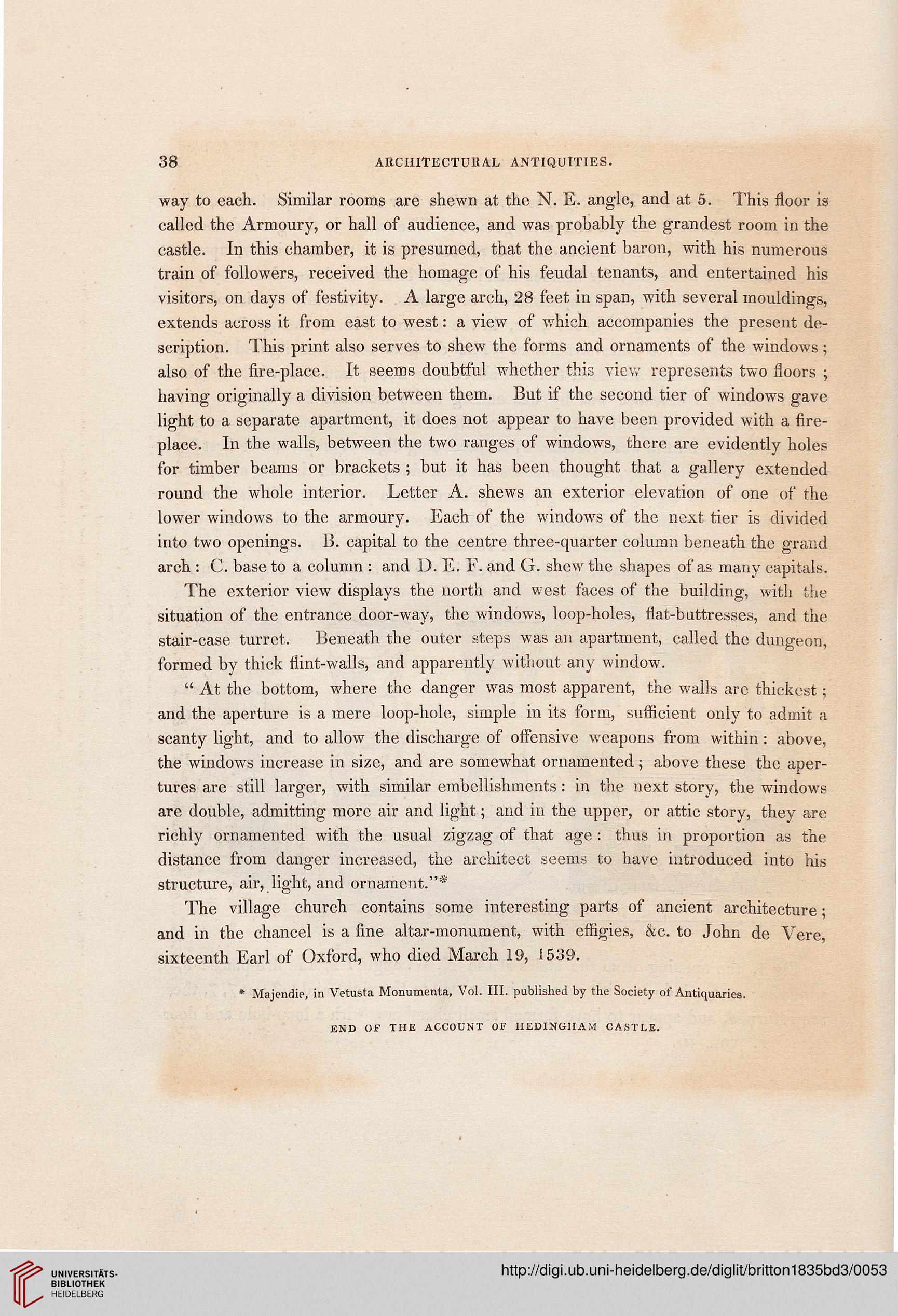38
ARCHITECTURAL ANTIQUITIES.
way to each. Similar rooms are shewn at the N. E. angle, and at 5. This floor is
called the Armoury, or hall of audience, and was probably the grandest room in the
castle. In this chamber, it is presumed, that the ancient baron, with his numerous
train of followers, received the homage of his feudal tenants, and entertained his
visitors, on days of festivity. A large arch, 28 feet in span, with several mouldings,
extends across it from east to west: a view of which accompanies the present de-
scription. This print also serves to shew the forms and ornaments of the windows;
also of the fire-place. It seems doubtful whether this view represents two floors ;
having originally a division between them. But if the second tier of windows gave
light to a separate apartment, it does not appear to have been provided with a fire-
place. In the walls, between the two ranges of windows, there are evidently holes
for timber beams or brackets ; but it has been thought that a gallery extended
round the whole interior. Letter A. shews an exterior elevation of one of the
lower windows to the armoury. Each of the windows of the next tier is divided
into two openings. B. capital to the centre three-quarter column beneath the grand
arch : C. base to a column : and D. E. F. and G. shew the shapes of as many capitals.
The exterior view displays the north and west faces of the building, with the
situation of the entrance door-way, the windows, loop-holes, flat-buttresses, and the
stair-case turret. Beneath the outer steps was an apartment, called the dungeon,
formed by thick flint-walls, and apparently without any window.
" At the bottom, where the danger was most apparent, the walls are thickest ;
and the aperture is a mere loop-hole, simple in its form, sufficient only to admit a
scanty light, and to allow the discharge of offensive weapons from within : above,
the windows increase in size, and are somewhat ornamented; above these the aper-
tures are still larger, with similar embellishments: in the next story, the windows
are double, admitting more air and light; and in the upper, or attic story, they are
richly ornamented with the usual zigzag of that age : thus in proportion as the
distance from danger increased, the architect seems to have introduced into his
structure, air, light, and ornament."*
The village church contains some interesting parts of ancient architecture •
and in the chancel is a fine altar-monument, with effigies, &c. to John de Vere,
sixteenth Earl of Oxford, who died March 19, 1539.
* Majendie, in Vetusta Monumenta, Vol. III. published by the Society of Antiquaries.
END OF THE ACCOUNT OF HEDINGHAM CASTLE.
ARCHITECTURAL ANTIQUITIES.
way to each. Similar rooms are shewn at the N. E. angle, and at 5. This floor is
called the Armoury, or hall of audience, and was probably the grandest room in the
castle. In this chamber, it is presumed, that the ancient baron, with his numerous
train of followers, received the homage of his feudal tenants, and entertained his
visitors, on days of festivity. A large arch, 28 feet in span, with several mouldings,
extends across it from east to west: a view of which accompanies the present de-
scription. This print also serves to shew the forms and ornaments of the windows;
also of the fire-place. It seems doubtful whether this view represents two floors ;
having originally a division between them. But if the second tier of windows gave
light to a separate apartment, it does not appear to have been provided with a fire-
place. In the walls, between the two ranges of windows, there are evidently holes
for timber beams or brackets ; but it has been thought that a gallery extended
round the whole interior. Letter A. shews an exterior elevation of one of the
lower windows to the armoury. Each of the windows of the next tier is divided
into two openings. B. capital to the centre three-quarter column beneath the grand
arch : C. base to a column : and D. E. F. and G. shew the shapes of as many capitals.
The exterior view displays the north and west faces of the building, with the
situation of the entrance door-way, the windows, loop-holes, flat-buttresses, and the
stair-case turret. Beneath the outer steps was an apartment, called the dungeon,
formed by thick flint-walls, and apparently without any window.
" At the bottom, where the danger was most apparent, the walls are thickest ;
and the aperture is a mere loop-hole, simple in its form, sufficient only to admit a
scanty light, and to allow the discharge of offensive weapons from within : above,
the windows increase in size, and are somewhat ornamented; above these the aper-
tures are still larger, with similar embellishments: in the next story, the windows
are double, admitting more air and light; and in the upper, or attic story, they are
richly ornamented with the usual zigzag of that age : thus in proportion as the
distance from danger increased, the architect seems to have introduced into his
structure, air, light, and ornament."*
The village church contains some interesting parts of ancient architecture •
and in the chancel is a fine altar-monument, with effigies, &c. to John de Vere,
sixteenth Earl of Oxford, who died March 19, 1539.
* Majendie, in Vetusta Monumenta, Vol. III. published by the Society of Antiquaries.
END OF THE ACCOUNT OF HEDINGHAM CASTLE.




